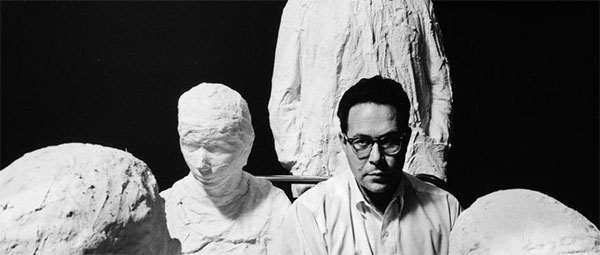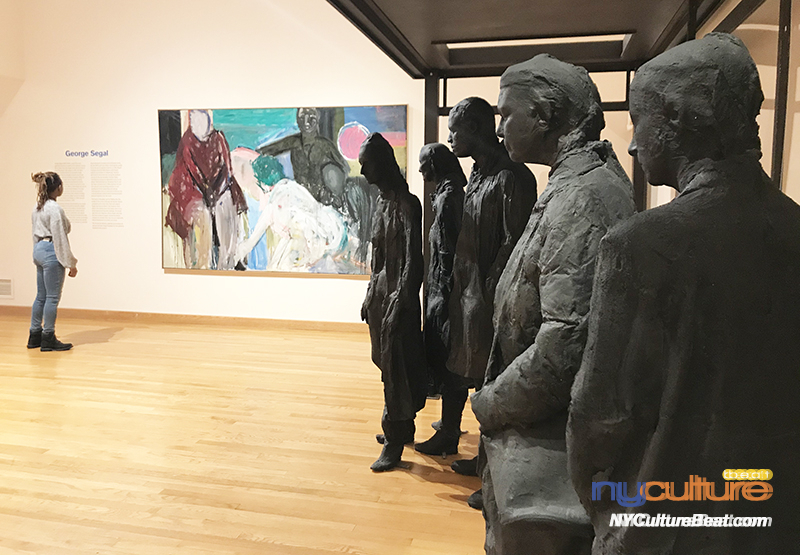조각가 조지 시걸 탄생 100주년 특별전 'George Segal: Themes and Variations'@럿거스대 지멀리미술관(1/24-7/31)
Celebrating George Segal and His Innovative Spirit at the Zimmerli
Explore the Artist’s Work in a Variety of Media, Over Four Decades

George Segal "Seated with Bus Riders," 1964-66, gelatin silver print. Courtesy of Rena Segal.
© Arnold Newman Properties/Getty Images.
New Brunswick, NJ (Jan. 12, 2024)—Marking the centennial of George Segal’s birth in 1924, the Zimmerli Art Museum at Rutgers—New Brunswick welcomes visitors to experience more than 60 works: some familiar, others rarely seen. The exhibition highlights not only the breadth of Segal’s work, but also the people and the state that helped to shape his career.
George Segal: Themes and Variations is on view from Jan. 24 to July 31, 2024. The public is invited to a free Opening Reception at the Zimmerli on Sat., Jan. 27, from 4:00 p.m. to 7:00 p.m.
With works drawn from the Zimmerli’s collection, as well as loans from the George and Helen Segal Foundation and private collections, the exhibition offers the unique opportunity to view Segal’s less well-known paintings, drawings, and photographs alongside his renowned life-sized plaster cast figures. In addition, photographs by Arnold Newman and Donald Lokuta capture Segal in his studio, providing insights into the artist as not only maker, but also curator who arranged the sculpture in his studio to convey connections across time and theme.
“This exhibition explores George Segal’s significance in art history, guiding his generation from abstraction back to realism,” said Maura Reilly, director of the Zimmerli. “It also reinforces the significant role that Rutgers—where he received his M.F.A.—and New Jersey played in the art world during the second half of the 20th century.”
Raised and educated in New York City, George Segal (1924-2000) relocated in the 1940s to a central New Jersey farm, which remained his home and studio for the rest of his life. In the 1950s and 1960s, Segal was among the avant-garde community of artists in Lower Manhattan, many of whom became his friends and mentors. Photographs document significant events such as Allan Kaprow’s Happenings, Fluxus events with Rutgers affiliated faculty, and Robert Frank’s filming of The Sin of Jesus at the farm.
The exhibition is structured to explore significant themes that Segal returned to throughout his career—figural groups, single figures, the nude, portraits, and still life. In addition, a group of Segal’s early expressionistic paintings from the late 1950s that won him renown as a young painter, but ultimately were left behind as he focused more intensely on sculpture, are included. Segal’s early paintings and figural sculptures, for which he is now best known, were focused on efforts by the artist to combine physical (visible) and emotional (invisible) subject matter.
With a gift of Johnson & Johnson’s new plaster bandages, Segal soon realized his signature technique of plaster cast figures, which he debuted in the historic New Realists at Manhattan’s Sidney Janis Gallery in 1962. Though it was the first major Pop art exhibition, Segal stood out for his ability to portray human psychology, rather than consumerism and pop culture. His sculptures captured gesture and posture and an uncanny sense of the model’s presence that was noted in the earliest reviews of his work. In sculptural groups such as The Dancers (1971), Appalachian Farm Couple (1991), and Bus Shelter (1996), he was also able to express the figures’ emotional connection to—or distance from—one other.
Segal also examined his love of art history and used still life to update the modernist still lifes of his favorite artists and his everyday experience. He was fascinated by Paul Cézanne’s ability to reimagine space and recreated one of the 19th-century artist’s still-life paintings in painted plaster. Segal also immortalized contemporary subjects from familiar places. The plaster sculpture Paint Cans with Wainscoting (1983) offers a vignette of items in his studio that suggests the artistic experiments of Robert Rauschenberg, Jean Follet, and Richard Stankiewicz, who also incorporated non-precious materials into their sculpture and assemblages. Segal, who loved to visit New Jersey diners, created a series of drawings and sculptures with table settings from the iconic local restaurants that he frequented.
Exhibition-related programs feature an interdisciplinary panel of scholars, including Rutgers faculty, about Segal and the topic of anti-monumentality, as well as two figure drawing workshops. Details are posted on the museum calendar. In addition, the exhibition is accompanied by a full-color catalogue of the same title, with Gustafson’s essay “Themes and Variations, Complications and Contradictions,” which examines his place in a community of artists and an expansive vision that underlies his work across different media, as well as a personal and illuminating interview with sculptor Charles Ray. It will be available in the museum and from Hirmer Publishers.
George Segal: Themes and Variations is organized by Donna Gustafson, Chief Curator and Curator of Art of the Americas. Generous support is provided by Art Bridges Foundation’s Access for All program. The exhibition is supported by the George and Helen Segal Foundation, the Zimmerli’s George Segal Endowment Fund, and Rutgers University, and donors to the Zimmerli’s Major Exhibitions Fund: Kathrin and James Bergin, Sundaa and Randy Jones, and Heena and Hemanshu Pandya. The book is funded in part by the Class of 1937 Publication Fund.

*George Segal at Zimmerli Art Museum, Rutgers University
뉴저지 럿거스대학 지멀리 미술관 <1> 조지 시걸(George Segal)
https://www.nyculturebeat.com/index.php?mid=Art2&document_srl=3877071
ZIMMERLI ART MUSEUM | RUTGERS
The Jane Voorhees Zimmerli Art Museum houses more than 60,000 works of art, with strengths in the Art of the Americas, Asian Art, European Art, Russian Art & Soviet Nonconformist Art, and Original Illustrations for Children's Literature. The permanent collections include works in all mediums, spanning from antiquity to the present day, providing representative examples of the museum’s research and teaching message at Rutgers, The State University of New Jersey, which stands among America’s highest-ranked, most diverse public research universities. Founded in 1766, as one of only nine colonial colleges established before the American Revolution, Rutgers is the nation’s eighth-oldest institution of higher learning.
VISITOR INFORMATION
Admission is free to the Zimmerli Art Museum at Rutgers. The museum is located at 71 Hamilton Street (at George Street) on the College Avenue Campus of Rutgers University in New Brunswick. The Zimmerli is a short walk from the NJ Transit train station in New Brunswick, midway between New York City and Philadelphia.
The Zimmerli Art Museum is open Wednesday and Friday, 11 a.m. to 6 p.m.; Thursday, 11 a.m. to 8 p.m.; Saturday and Sunday, noon to 5 p.m. The museum is closed Monday and Tuesday, as well as major holidays and the month of August.
For the most current information, including parking and accessibility, visit zimmerli.rutgers.edu.





